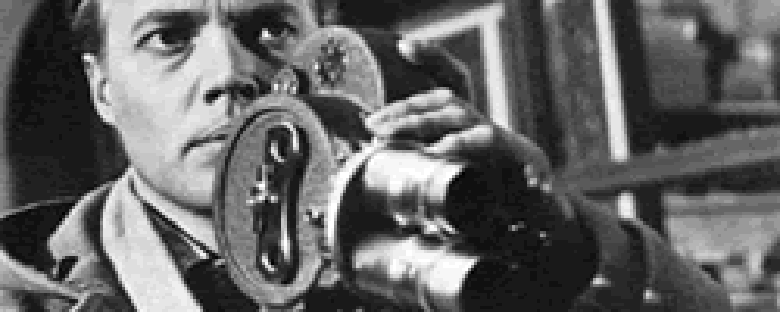Reviews
Michael Powell
UK, 1960
Credits
Review by Rumsey Taylor
Posted on 11 July 2004
Source The Criterion Collection DVD
The camera relays a powerfully humanistic quality in that it sees, and more importantly, remembers. There are other devices that mimic human action; none are potentially more intimidating. The camera is as discerning as the human eye — it is what it is designed after.
This claim is inherent to Peeping Tom. The film opens with a fearsome point-of-view shot: a camera pans across a dark London street. The subjective view sights a prostitute. “It’ll be two quid,” her cockney voice sounds. The cameraman’s hand deposits an empty box of film into the garbage, and the woman is followed up a case of stairs.
Above the woman lays on a bed, facing the camera. The view shifts left, and the vision is briefly obscured. The angle tilts back to its former position, a noticeable glare appears over the woman’s face. She stares back at us with fright, and screams. The camera closes in on the woman’s expression of authentic terror. Shortly after, the developed film is seen projected in the darkened venue of a private screening.
Mark Lewis is the cameraman — and killer — responsible for the opening scene. The resulting footage (running behind the title credits) repeats the prior action. There is a controversial psychology at play: Mark films his killings, and will edit the footage into a documentary study of fear. In addition, he films the police finding the body, the newspaper headlines, and others’ reactions. In his crimes he is entirely omniscient, benefiting from the knowledge the media seeks. Mark, much like the director of a work of fiction, is afforded this rare masochistic opportunity.
Peeping Tom followed a train of successes from British filmmaker Michael Powell, who, along with scenarist Emric Pressberger, is responsible for The Red Shoes, Black Narcissus, and The Life and Death of Colonel Blimp; Peeping Tom was critically rejected and banned, and although not his final film, it is seen as Powell’s career-ender.
The film’s controversy is timeless, as it visibly exploits the voyeuristic nature of film. Mark’s point-of-view (as in the opening shot) is frequented, with each turn revealing more of his scheme, culminating in the revelation of his ongoing study. The aforementioned “glare” results from a mirror affixed to the camera’s lens — Mark’s victims’ terror results from the image of their own death.
Mark clutches his camera with the instinctive defense of a mother. When he is without the device, as when a police officer inspects it, he mimics the actions of others, enacting what he sees, recording it. The camera is an extension of Mark’s psyche; it is the literal manifestation of his masochistic gaze.
Unlike other psychologically disturbed characters in film, Mark admits his sickness. He realizes, also, that there is no quick remedy. His “studies” emulate his father’s — a renowned biologist who studied reactions of the nervous system to fear. Mark reminisces episodes from his youth in which he would awaken, screaming, disturbed by a lizard placed upon him in his sleep. He was his father’s test subject.
Mark’s mother died in his childhood (his father filmed him grasping the hand of her corpse). She was replaced soon after (a “surrogate mother” he calls her). In this manner Mark has been deprived of a maternal relationship. He accepts the most domineering familial influence, his father’s masochistic experimentation. The iconoclastic “mother” has been removed from Mark’s existence; this deprivation fosters a misogynistic social view, and Mark’s victims are all women.
The sexual impetus fueling Mark’s crimes becomes complicated once a super-curious neighbor, Helen, takes interest in Mark (he is, however reclusive, attractively mysterious). The two go on a date later in the film, and she kisses him afterward. Judging from his reaction, it is a rare example of affection for Mark, who then presses his camera’s lens to his lips.
Peeping Tom opened months prior to the 1960 release of Psycho. In comparison, the films demonstrate differentiated approaches to horror, although both are comparably horrific: Psycho emphasizes visceral action; Peeping Tom is more cerebral.
However, Psycho is limited in the existential relevance of its horror; Peeping Tom, conversely, is akin to the psychological nature of filmmaking. No film, simply, more rightly depicts the psychology of helming a camera, fashioning scenario, and filming it. Directors are alchemists, and characters are pawns to exercise their every temptation, impulse, motivation, fear, or sin.
There is a looming presence in Peeping Tom. Many shots are seen through a camera’s viewfinder (its crosshairs appear on screen); in this manner the viewer is forced to identify with the killer. His victims, screaming at the sight of their own death, look back with fear — and they are looking towards us.
No film, to mind, better degrades the position of the viewer.
We don’t do comments anymore, but you may contact us here or find us on Twitter or Facebook.



